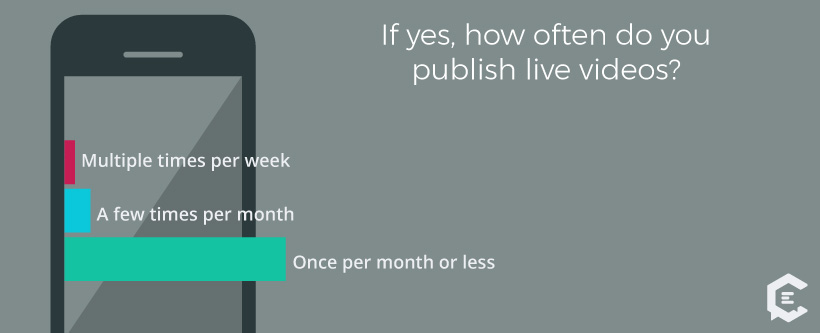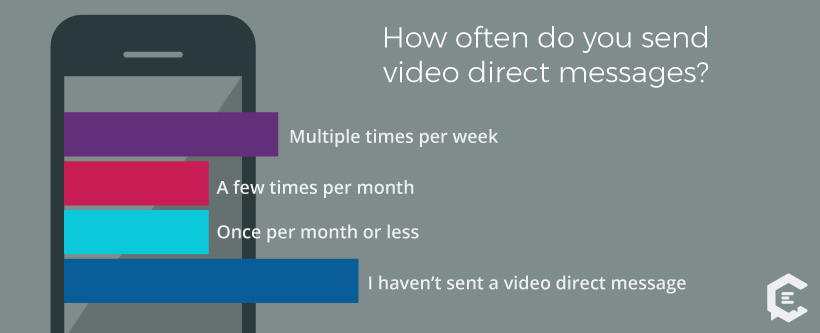Millennials use social video for a variety of reasons, from research and entertainment to communication with friends. Surprisingly, most millennials surveyed by ClearVoice have never published live video. Of the 33% of millennials who do publish live video, only 14% of that subset go live more than once per month.
Social pundits will tell you that you need to invest more time and money into creating social videos for millennials, but what does your millennial audience actually want? ClearVoice decided to do an informal survey of nearly 150 millennials — mostly between the ages of 18-24 — to find out their opinions about online videos. Many of the results were to be expected, but some of the ways millennials engage with social videos may surprise you.
Here’s what we learned.
First, a question to set the stage:

No surprise here. Virtually every respondent is using social media multiple times per day. According to a MediaKix survey, the average person spends nearly two hours per day on social media. On average, those same survey respondents spent 40 minutes per day on YouTube; 35 minutes on Facebook; 25 minutes on Snapchat; and 15 minutes on Instagram.
Next, millennials’ social video consumption habits:
For sure, some great content that is more than a couple of minutes long pops up on news feeds, but if all things are even, it looks like the sweet spot for reaching millennials is between 30-60 seconds. Another way to look at this might be to say that 9 out of every 10 millennials responded that the optimal length for a social video is two minutes or less.
A study performed by HubSpot backs up this data, though Hubspot also claims that the optimal length depends on the channel on which the content is being consumed. According to the report, Instagram videos that received the most comments were about 26 seconds long. Therefore, it is safe to assume that the magic spot for Instagram videos is about 30 seconds or less.
Facebook videos tend to be able to capture users’ attention for a bit longer. Hubspot reports that its respondents engaged the most with videos that were approximately one minute long. If an organization wants to create a longer video, the report indicates that YouTube might be the optimal channel, as the most-engaged with videos are about two minutes long, according to the report. An example of an effective two-minute YouTube video is evidenced Coca-Cola spot:
When a video is available along with an article or blog post and the information is identical, nearly four times as many millennials said they would prefer to watch the video rather than read the article. About 1 in 5 respondents said they would invest the time to both read the article and watch the video.
Of course, if you are promoting a product, keep in mind this tidbit from an Animoto Survey: Four times as many consumers would rather watch a video about a product than read about it. Given this information, it is no wonder that video marketing has exploded in recent years and looks to continue to be a popular option for content marketers and content creators in the future.
Still, the question begs to be asked — why? What is it about video that engages millennials?
Defy Media decided to look into the video phenomenon for millennials and found the following reasons why they choose to watch videos:
- A full 77 percent claim that they watch video to kill boredom and fill time.
- Nearly 2/3 (63 percent) say they use video to keep up with celebrities, sports, and fashion.
- About 3 in 5 (61 percent) said they watch videos as a form of stress relief.
- Likewise, 60 percent say they watch videos to keep up with the latest news and events.
- Nearly half (47 percent) say they watch videos to help them learn how to do something.
- More than 2 in 5 (44 percent) claim they watch video to fall asleep.
Perhaps the number of videos that millennials are seeing on social hasn’t quite reached saturation level — but we may be close to that point. More than 2/3 of respondents said that they want to see about as many videos in their social feed as they currently see, whereas only about 14 percent said they wanted to see more videos than they currently see.
Conventional wisdom says that you will get more engagement by creating videos, but when everybody is creating videos, perhaps opting for other non-video methods to communicate your messages from time to time might also be valuable.
Of course, it also could be true that as people continue to be exposed to more videos, they become more accustomed to that type of content and don’t care as much for other types of content. Already, 85 percent of the U.S. web audience watches video and those ages 25-34 watch more than older generations. So it’s hard to say that we will actually see any sort of decrease in video creation or consumption.
Of course, users’ desire to consume video will always also be dependent on the quality of the videos. In examining some of the top brand YouTube videos, ListenFirst Media has found that many of the top videos focus on a narrative. They also often use humor, family, and inspiration to increase engagement.
Surprisingly, all three of these options were selected by a significant number of people. If anything is to be learned, perhaps it is that videos from brands can be just as effective as videos from friends and influencers. It is important, however, to pay special attention to this key detail:
Respondents are referring to a brand that they already engage with. One should only assume that your branded video content is going to be effective at reaching millennials as videos from friends, family members or influencers if these millennials are already engaging with your content on a regular basis.
Many brands are firmly aboard the influencer train, though simply using an influencer in your video is not enough by itself. As referenced above, the content still should be compelling. A good example of a compelling influencer videos is found in a partnership between Lewis Hilsenteger of the Unbox Therapy YouTube channel and Segway.
The two entities combined for an entertaining and educational video about the new Segway miniPRO. For your products, you may not have the budget to use major influencers, but engaging the right number of micro-influencers who have influence over your young adult target audience could be effective.
Is it possible that the demise of Facebook among millennial audiences is greatly exaggerated? Perhaps. Nearly half of respondents claimed that they prefer to watch videos on Facebook. With the time and resources Facebook is putting into its Watch feed, one would assume they have research to suggest that millennial audiences will use it.
Though Instagram and Snapchat are both popular channels among millennials, only 17 percent of our respondents say they prefer to watch videos on Instagram and 8 percent say they prefer to watch videos on Snapchat.
One potential conclusion to this result might be that millennials may prefer to watch polished videos that they might be more likely to see on Facebook and YouTube rather than low-fidelity videos that they may see on Snapchat or Instagram.
Still, the videos you produce don’t necessarily need to be Hollywood quality in order to be shared. If you can create a video that informs, entertains, or otherwise delights viewers in an unexpected way, your video content is much more likely to be viewed. Take, for example, this Facebook video which has more than 38 million views that shows a primitive way to make paper.
Making paper isn’t something that most think about on a regular basis, but it was interesting enough to make it a huge hit.
Lastly, social video creation habits for millennials:
In early 2017, Facebook CEO Mark Zuckerberg mentioned that 1 in every 5 videos published on Facebook was a live video. Though live videos coming from our millennials may not be as prevalent as expected, about 1 in 3 of our survey respondents have published a live video to a social channel.
It seems as if the usage of live video among millennials is a little more prevalent than you might find among the general population. Cisco reports that live video now makes up for 13 percent of all videos viewed.
Not only have most the millennials we surveyed not published live videos — but those who have published live videos don’t publish them very often. Of the 33 percent of respondents who said they have published a live video, only 14 percent of those respondents said they publish live videos more often than once per month.
Though millennials may still be a little camera shy when it comes to publishing their own live videos, they are considerably more outgoing when it comes to sharing video direct messages. More than 1 in 4 of our respondents said they send direct messages with video multiple times per week and nearly two-thirds of respondents have sent a video direct message at some point.
Summary
We don’t suggest you use any of these numbers from our informal survey as your only source, but we do invite you to consider what these results might mean for your brand and encourage you to delve deeper on the video responses that you find most intriguing.











